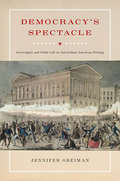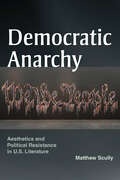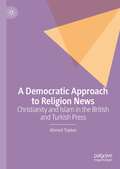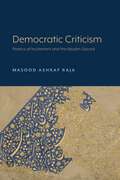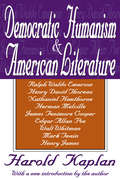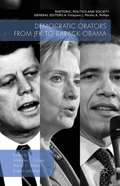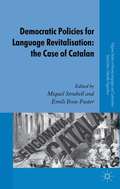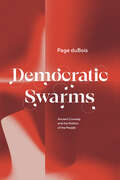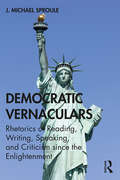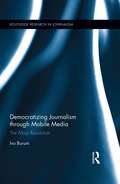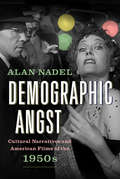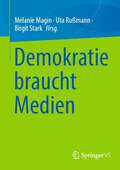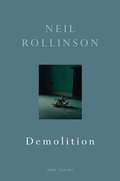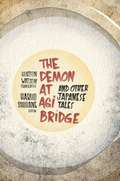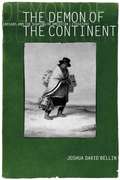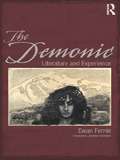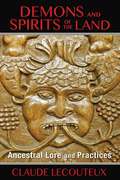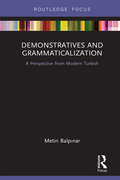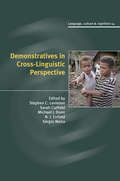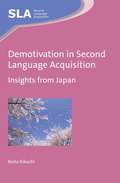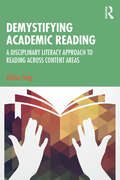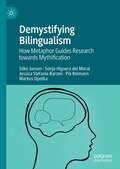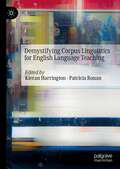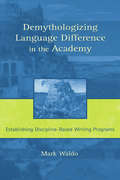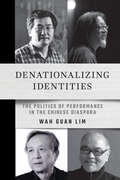- Table View
- List View
Democracy's Spectacle: Sovereignty and Public Life in Antebellum American Writing
by Jennifer Greiman"What is the hangman but a servant of law? And what is that law but an expression of public opinion? And if public opinion be brutal and thou a component part thereof, art thou not the hangman's accomplice?" Writing in 1842, Lydia Maria Child articulates a crisis in the relationship of democracy to sovereign power that continues to occupy political theory today. Is sovereignty, with its reliance on singular and exceptional power, fundamentally inimical to democracy? Or might a more fully realized democracy distribute, share, and popularize sovereignty, thus blunting its exceptional character and its basic violence? In Democracy's Spectacle, Jennifer Greiman looks to an earlier moment in the history of American democracy's vexed interpretation of sovereignty to argue that such questions about the popularization of sovereign power shaped debates about political belonging and public life in the antebellum United States. In an emergent democracy that was also an expansionist slave society, Greiman argues, the problems that sovereignty posed were less concerned with a singular and exceptional power lodged in the state than with a power over life and death that involved all Americans intimately.Drawing on Alexis de Tocqueville's analysis of the sovereignty of the people in Democracy in America, along with work by Gustave de Beaumont, Lydia Maria Child, Nathaniel Hawthorne, and Herman Melville, Greiman tracks the crises of sovereign power as it migrates out of the state to become a constitutive feature of the public sphere. Greiman brings together literature and political theory, as well as materials on antebellum performance culture, antislavery activism, and penitentiary reform, to argue that the antebellum public sphere, transformed by its empowerment, emerges as a spectacle with investments in both punishment and entertainment.
Democratic Anarchy: Aesthetics and Political Resistance in U.S. Literature
by Matthew ScullyA dramatic and necessary rethinking of the meaning of DemocracyDemocratic Anarchy grapples with an uncomfortable but obvious truth inimical to democracy: both aesthetics and politics depend on the structuring antagonism of inclusion and exclusion. Yet in Democratic Anarchy, Matthew Scully asks, how can “the people” be represented in a way that acknowledges what remains unrepresentable? What would it mean to face up to the constitutive exclusions that haunt U.S. democracy and its anxious fantasies of equality?Synthesizing a broad range of theoretical traditions and interlocutors—including Lacan, Rancière, Edelman, and Hartman—Democratic Anarchy polemically declares that there has never been, nor can there ever be, a realized democracy in the U.S. because democracy always depends on the hierarchical institution of a formal order by one part of the population over another. Engaging with an expansive corpus of American literature and art (Harriet Jacobs, Nathaniel Hawthorne, Louis Zukofsky, Thomas Pynchon, Toni Morrison, Theresa Hak Kyung Cha, Nari Ward, Ocean Vuong, and Safiya Sinclair), Democratic Anarchy argues that many liberal concepts and institutions are in fact structurally opposed to democratic equality because they depend on regulating what can appear and in what form.By focusing on works that disrupt this regulatory impulse, Scully shows how rhetorical strategies of interruption, excess, and disorder figure the anarchic equality that inegalitarian fantasies of democracy disavow. Democratic Anarchy develops a rigorous theory of equality that refuses to repeat the inequalities against which it positions itself, and it does so by turning to moments of resistance—both aesthetic and political—inaugurated by the equality that inheres in and antagonizes the order of things.
A Democratic Approach to Religion News: Christianity and Islam in the British and Turkish Press
by Ahmed TopkevThis book introduces the first systematic and unified four-dimension democratic approach to newspaper religion reporting. It explores the coverage of faith, with a particular focus on Christianity and Islam, in the British and Turkish national press. The results of framing analysis, conducted through content analysis of 1,022 news articles, reveal that, in both countries, alongside the contrasting portrayals of the minority religions, even the dominant religions had a disproportioned employment of the four dimensions – spiritual, world life, political, and conflict. It contributes to scholarship not only empirically but also theoretically and methodologically, with its theoretical and methodological contribution surpassing its empirical findings. As such, it will transcend geographical and temporal boundaries, making it appealing and relevant to an international audience of academics, professionals, and students in the fields of journalism, religion, democracy, media, communication, society, and culture, as well as individuals from various backgrounds.
Democratic Criticism: Poetics of Incitement and the Muslim Sacred
by Masood Ashraf RajaAfter the publication of Salman Rushdie’s The Satanic Verses (1988), the poetics of incitement— found in texts originating in the West containing themes and representations of Islam hurtful to Muslims—became an accepted method of textual production in the West. Production of such texts intensified after the attacks of 9/11. Democratic Criticism: Poetics of Incitement and the Muslim Sacred by Masood Ashraf Raja urges a new mode of reading, one that permits Western readers to transcend local reading practices in order to, as best as one can, read from the point of view of the Other. Raja argues that the lack of understanding of Muslim responses to the poetics of incitement in the West is the result of a lack of cross-cultural knowledge. He claims metropolitan universities often do not teach the proper social, historical, and religious context required for effectively reading these texts with any form of cultural knowledge. To remedy this, Raja offers and theorizes “democratic reading practices” and new ways for students to engage with texts. A genealogy of the Muslim Sacred is included, thereby giving readers the history and specific knowledge that constitutes an average Muslim reader of these texts, a subject who should be imagined and empathized with when those in the West read works of the poetics of incitement. Democratic Criticism encourages Western readers to develop a deeper understanding of the meaning-making processes of the Islamic world while at the same time encouraging the Muslim readers to read representations of the Islamic world with a more expansive understanding. It will be a helpful tool in creating reading practices that allow both teachers and students of literature to transcend their mode of reading as universal and to read from the perspective of the Other, and allow readers to engage meaningfully with these texts. Students and scholars of world literature, history, and religious studies will find this book insightful and valuable.
Democratic Humanism and American Literature
by Harold KaplanDemocratic Humanism and American Literature illustrates the interplay between democratic assumptions and literary performance in the America's classic nineteenth-century writers--Emerson, Thoreau, Hawthorne, Melville, Cooper, Poe, Whitman, Twain, and James. Harold Kaplan suggests that these major figures' works are linked by the myths of genesis of a new political culture. Challenged by the democratic ideal, and committed to it, they wrote prophetic books in the American liberal tradition and endowed its ethical intelligence.The task of stating a new and undefined freedom was always implicit and often in the foreground of the writing of these nineteenth-century giants. As the author describes the situation, "the free man had to decide in what sense he was bound by nature or could master it; in what sense he was committed to his society and could reconcile his freedom with it." These classic writers devoted their work to examining this dialectic of values; Kaplan sees their complex and polarized democratic consciousness as seminal in the imaginative tradition they generated. What is unique in that tradition of values is the rivalry of criticism with affirmations of faith. "The highly original ethical trait involved here is based on the capacity of a political society to use its negations against itself and survive."The author suggests that in our own time moral judgments are more likely to be the province of activist politics than literature. His new introduction relates the theme of the book to cultural and political developments in the American experience of modernity and adds a discussion of Wallace Stevens and William Carlos Williams to the figures treated in the original edition. Since tendencies to develop ideological and idiosyncratic responses to extrinsic events have grown stronger over time, it is more important than ever for scholars and students alike to recover a "moral imagination"--the force that gave rise to the great literary works of the nineteenth century. To describe that force is Harold Kaplan's goal in Democratic Humanism and American Literature.
Democratic Orators from JFK to Barack Obama (Rhetoric, Politics And Society Ser.)
by Andrew Crines David Moon Robert LehrmanHow do leading Democratic Party figures strive to communicate with and influence their audience? Why have some proven more successful than others in advancing their ideological arguments? How do orators seek to connect with different audiences in different settings such as the Senate, conventions and through the media? This thoroughly researched and highly readable collection comprehensively evaluates these questions as well as providing an extensive interrogation of the political and intellectual significance of oratory and rhetoric in the Democratic Party. Using the Aristotelian modes of persuasion ethos, pathos and logos it draws out commonalties and differences in how the rhetoric of Democratic Party politics has shifted since the 1960s. More broadly it evaluates the impact of leading orators upon American politics and argues that effective oratory remains a vital party of American political discourse.
Democratic Policies for Language Revitalisation: the Case of Catalan
by Miquel Strubell Emili Boix-FusterA collection of studies offering an up-to-date analysis of official policies to promote Catalan in a democratic framework in each of the main Spanish regions where it is spoken: Catalonia, Valencia and the Balearic Islands.
Democratic Swarms: Ancient Comedy and the Politics of the People
by Page duBoisConsiders how ancient Greek comedy offers a model for present-day politics. With Democratic Swarms, Page duBois revisits the role of Greek comedy in ancient politics, considering how it has been overlooked as a political medium by modern theorists and critics. Moving beyond the popular readings of ancient Greece through the lens of tragedy, she calls for a revitalized look at Greek comedy. Rather than revisiting the sufferings of Oedipus and his family or tragedy’s relationship to questions of sovereignty, this book calls for comedy—its laughter, its free speech, its wild swarming animal choruses, and its rebellious women—to inform another model of democracy. Ancient comedy has been underplayed in the study of Greek drama. Yet, with the irrepressible energy of the comic swarm, it provides a unique perspective on everyday life, gender and sexuality, and the utopian politics of the classical period of Athenian democracy. Using the concepts of swarm intelligence and nomadic theory, duBois augments tragic thought with the resistant, utopian, libidinous, and often joyous communal legacy of comedy, and she connects the lively anti-authoritarianism of the ancient comic chorus with the social justice movements of today.
Democratic Vernaculars: Rhetorics of Reading, Writing, Speaking, and Criticism since the Enlightenment
by J Michael SprouleDemocratic Vernaculars is a comprehensive, culturally inclusive, and thematically unified history of the communicative, audience-centered rhetorical vernacular that occupies the “middle range” of English, bounded on the one side by expressive structure (grammar and linguistics) and on the other by aesthetics (literature). Broadening the history of rhetoric by considering a vast collection of vernacular resources such as elementary grammars and readers, popular guidebooks, textbooks, and rhetorical treatises, this book advances the history of the rhetorical theory and pedagogy since the 17th century by examining ways in which diverse vectors of the rhetorical vernacular coalesced to produce an English language sufficiently idiomatic for practical social exchange while being, at the same time, suitable for higher literary, scholarly, and cultural pursuits. Democratic Vernaculars is essential reading for scholars in rhetoric and the histories of language and education, and can serve as a text for upper-division undergraduate and graduate courses in rhetoric.
Democratizing Journalism through Mobile Media: The Mojo Revolution (Routledge Research in Journalism)
by Ivo BurumFuelled by a distrust of big media and the development of mobile technologies, the resulting convergence of journalism praxis (professional to alternative), workflows (analogue to multipoint digital) and platforms (PC to mobile), result in a 24-hour always-on content cycle. The information revolution is a paradigm shift in the way we develop and consume information, in particular the type we call news. While many see this cultural shift as ruinous, Burum sees it as an opportunity to utilize the converging information flow to create a galvanizing and common digital language across spheres of communication: community, education and mainstream media. Embracing the digital literacies researched in this book will create an information bridge with which to traverse journalism’s commercial precarity, the marginalization of some communities, and the journalism school curricula.
Demographic Angst: Cultural Narratives and American Films of the 1950s
by Alan NadelProlific literature, both popular and scholarly, depicts America in the period of the High Cold War as being obsessed with normality, implicitly figuring the postwar period as a return to the way of life that had been put on hold, first by the Great Depression and then by Pearl Harbor. Demographic Angst argues that mandated normativity—as a political agenda and a social ethic—precluded explicit expression of the anxiety produced by America’s radically reconfigured postwar population. Alan Nadel explores influential non-fiction books, magazine articles, and public documents in conjunction with films such as Singin’ in the Rain, On the Waterfront, Sunset Boulevard, and Sayonara, to examine how these films worked through fresh anxieties that emerged during the 1950s.
Demokratie braucht Medien
by Melanie Magin Uta Rußmann Birgit StarkFreie und unabhängige Medien sind die Grundlage einer lebendigen Demokratie. In normativen Demokratiemodellen wird die „Wächterrolle“ von Medien betont, weil neben der Kontroll- und Informationsfunktion der Medien ihr Beitrag zur Legitimierung politischer Prozesse als zentral angesehen wird. Medien unterliegen jedoch im digitalen Wandel einem hohen Anpassungsdruck: Sie drohen ihre traditionelle Gatekeeper-Rolle zu verlieren und konkurrieren mit globalen Tech-Giganten wie Facebook und Google um Werbegelder und die Aufmerksamkeit des Publikums. Die Plattformisierung der Medien stellt nicht nur die Vermittlungsleistungen professioneller journalistischer Informationsanbieter in Frage, sondern auch die Rolle der Medien in der Herstellung von Öffentlichkeit. Der Band hinterfragt die sich wandelnde Rolle der Medien im politischen System sowie das Verhältnis von Medien und Politik kritisch. Funktionen und Autonomiegrad von Medien und Journalismus werden analysiert. Mithilfe von Zeitvergleichen werden tiefgreifende Veränderungen wie auch Konstanten herausgearbeitet. Nicht zuletzt gilt es zu erörtern, welche Akteure welche Verantwortung tragen und welche Privilegien sie genießen (sollten).
Demolition
by Neil RollinsonWith the frank, subversive, and very funny poems in his first two books, Neil Rollinson established himself as a deft cartographer of the sensual world. While a rich and tactile eroticism still courses through Demolition, there is a new seriousness here, as mortality starts to throw its long shadow. These poems occupy a more rueful, reflective space - provisional, mercurial and fragile - a darker place where disintegration and loss are the only certainties, and memory is the only solid ground. Central to this is the death of the father - whether the poet's own, or the lost fathers of Borges or Vallejo - and the theme is broadened through a number of moving examinations of the erosion of time and youth. Against this gathering darkness, Rollinson sets a spirited defence, blending the lyric and vernacular voice in a muscular celebration of food, sex, sport and the natural world that is unusually refreshing, and sophisticated enough to allow both humour and profundity.The poems in Demolition never give up hope; they exhibit a tenacious optimism - or at least a steely pragmatism - that says: we have what we are given, there is no alternative, and we all must find what joy we can in life, and in its living.
The Demon at Agi Bridge and Other Japanese Tales (Translations from the Asian Classics)
by Shirane Haruo ed. Translated by Burton WatsonBurton Watson and Haruo Shirane, renowned translators and scholars, introduce English-speaking readers to the vivid tradition of early and medieval Japanese anecdotal (setsuwa) literature. These orally narrated and written tales drew on both local folk tradition and continental sources. Taken from seven major anthologies of anecdotal literature compiled between the ninth and thirteenth centuries, these dramatic and often amusing stories open a major window onto the foundations of Japanese culture.Out of thousands of setsuwa, Shirane has selected thirty-eight of the most powerful and influential, each of which is briefly introduced. Recounting the exploits of warriors, farmers, priests, and aristocrats, and concerning topics as varied as poetry, violence, power, and sex, these tales reveal the creative origins of a range of literary and dramatic genres, from court tales and travel accounts to no drama and Kabuki. Watson's impeccable translations relay the wit, mystery, and Buddhist sensibility of these protean works, while Shirane's sophisticated analysis illuminates the meaning and context of their compact stories. Capped by an extensive bibliography, this collection fully immerses the reader in the thrilling world of secular and religious tales.
The Demon of the Continent
by Joshua David BellinIn recent years, the study and teaching of Native American oral and written art have flourished. During the same period, there has been a growing recognition among historians, anthropologists, and ethnohistorians that Indians must be seen not as the voiceless, nameless, faceless Other but as people who had a powerful impact on the historical development of the United States. Literary critics, however, have continued to overlook Indians as determinants of American--rather than specifically Native American--literature. The notion that the presence of Indian peoples shaped American literature as a whole remains unexplored.In The Demon of the Continent, Joshua David Bellin probes the complex interrelationships among Native American and Euro-American cultures and literatures from the mid-seventeenth to the mid-nineteenth centuries. He asserts that cultural contact is at the heart of American literature. For Bellin, previous studies of Indians in American literature have focused largely on the images Euro-American writers constructed of indigenous peoples, and have thereby only perpetuated those images. Unlike authors of those earlier studies, Bellin refuses to reduce Indians to static antagonists or fodder for a Euro-American imagination.Drawing on works such as Henry David Thoreau's Walden, William Apess' A Son of the Forest, and little known works such as colonial Indian conversion narratives, he explores the ways in which these texts reflect and shape the intercultural world from which they arose. In doing so, Bellin reaches surprising conclusions: that Walden addresses economic clashes and partnerships between Indians and whites; that William Bartram's Travels encodes competing and interpenetrating systems of Indian and white landholding; that Catherine Sedgwick's Hope Leslie enacts the antebellum drama of Indian conversion; that James Fenimore Cooper and Henry Wadsworth Longfellow struggled with Indian authors such as George Copway and David Cusick for physical, ideological, and literary control of the nation.The Demon of the Continent proves Indians to be actors in the dynamic processes in which America and its literature are inescapably embedded. Shifting the focus from textual images to the sites of material, ideological, linguistic, and aesthetic interaction between peoples, Bellin reenvisions American literature as the product of contact, conflict, accommodation, and interchange.
The Demonic: Literature and Experience
by Ewan FernieAre we either good or bad, and do we really know the difference? Why do we want what we cannot have, and even to be what we’re not? Can we desire others without wanting to possess them? Can we open to others and not risk possession ourselves? And where, in these cases, do we draw the line? Ewan Fernie argues that the demonic tradition in literature offers a key to our most agonised and intimate experiences. The Demonic ranges across the breadth of Western culture, engaging with writers as central and various as Luther, Shakespeare, Hegel, Dostoevsky, Melville and Mann. A powerful foreword by Jonathan Dollimore brings out its implications as an intellectual and stylistic breakthrough into new ways of writing criticism. Fernie unfolds an intense and personal vision, not just of Western modernity, but of identity, morality and sex. As much as it’s concerned with the great works, this is a book about life.
Demons and Spirits of the Land: Ancestral Lore and Practices
by Claude LecouteuxAn exploration of the wild spirits that once roamed the lands and inhabited the waters and the pagan rites used to gain their good will • Explores medieval stories and folk traditions of brownies, fairies, giants, dragons, will-o’-the-wisps, and demons • Explains the specific rites performed to negotiate with the local spirits and ensure their permission before building on new land • Shows how these beliefs carried through to modern times, especially in architecture Our pagan ancestors knew that every forest has brownies and fairies, every spring its lady, and every river malevolent beings in its depths. They told tales of giants in the hills, dragons in the lakes, marshes swarming with will-o’-the-wisps, and demons and wild folk in the mountains who enjoyed causing landslides, avalanches, and floods. They both feared and respected these entities, knowing the importance of appeasing them for safe travel and a prosperous homestead. Exploring medieval stories, folk traditions, spiritual place names, and pagan rituals of home building and site selection, Claude Lecouteux reveals the multitude of spirits and entities that once inhabited the land before modern civilization repressed them into desert solitude, impenetrable forests, and inaccessible mountains. He explains how, to our ancestors, enclosing a space was a sacred act. Specific rites had to be performed to negotiate with the local spirits and ensure proper placement and protection of a new building. These land spirits often became the household spirit, taking up residence in a new building in exchange for permission to build on their territory. Lecouteux explores Arthurian legends, folk tales, and mythology for evidence of the untamed spirits of the wilderness, such as giants, dragons, and demons, and examines the rites and ceremonies used to gain their good will. Lecouteux reveals how, despite outright Church suppression, belief in these spirits carried through to modern times and was a primary influence on architecture, an influence still visible in today’s buildings. The author also shows how our ancestors’ concern for respecting nature is increasingly relevant in today’s world.
Demonstratives and Grammaticalization: A Perspective from Modern Turkish
by Metin BalpınarDemonstratives and Grammaticalization offers an in-depth analysis of the demonstrative system in Turkish. This book provides the first comprehensive analysis dealing with both the synchronic variations in Turkish demonstratives and their grammatical changes. It sheds light on the syntactic, semantic, and pragmatic properties of the demonstratives, systematically describes the various usages of these forms, and provides a unified explanation for the various accounts of their distribution. While the focus is on Turkish, this analysis contributes to our understanding of how a demonstrative system operates in a language with a three-way distinction.
Demonstratives in Cross-Linguistic Perspective (Language Culture and Cognition #14)
by Stephen Levinson Sarah Cutfield Michael Dunn Nick Enfield Sergio Meira David WilkinsDemonstratives play a crucial role in the acquisition and use of language. Bringing together a team of leading scholars this detailed study, a first of its kind, explores meaning and use across fifteen typologically and geographically unrelated languages to find out what cross-linguistic comparisons and generalizations can be made, and how this might challenge current theory in linguistics, psychology, anthropology and philosophy. Using a shared experimental task, rounded out with studies of natural language use, specialists in each of the languages undertook extensive fieldwork for this comparative study of semantics and usage. An introduction summarizes the shared patterns and divergences in meaning and use that emerge.
Demotivation in Second Language Acquisition
by Keita KikuchiSLA literature tends to focus predominantly on what motivates language learners, but what demotivates them has not been widely discussed. This book, focusing exclusively on demotivation, will help readers to understand motivational issues from a different perspective. The aims of the work are threefold: to present the current developments of demotivation research in the field of SLA and bridge motivational theory/research and demotivation research; to promote the understanding of possible causes of demotivation; and to expand the focus of demotivation research through a reflection on current motivation theory/research and a discussion of methodological issues. The research presented in this book is situated in Japanese English-teaching contexts and will serve as a foundation for anyone wishing to better understand the causes of demotivation in SLA and to explore the topic in their own contexts.
Demystifying Academic Reading: A Disciplinary Literacy Approach to Reading Across Content Areas
by Zhihui FangFoundational and accessible, this book equips pre-service and practicing teachers with the knowledge, understanding, tools, and resources they need to help students in grades 4–12 develop reading proficiencies in four core academic subjects—literature, history, science, and mathematics. Applying a disciplinary literacy approach, Fang describes the verbal and visual resources, expert strategies, inquiry skills, and habits of mind that students must learn in order to read carefully, critically, purposefully, and with an informed skepticism across genres and content areas. He also shows how teachers can promote language learning and reading/literacy development at the same time that they engage students in content area learning. With informative synthesis and research-based recommendations in every chapter, this text prepares teachers to help students develop discipline-specific, as well as discipline-relevant, discursive insights, literacy strategies, and ways of thinking, reasoning, and inquiring that are essential to productive learning across academic subjects. It also provides teacher educators with approaches and strategies for helping teacher candidates develop expertise in academic reading instruction. In so doing, the book demystifies academic reading, revealing what it takes for students to read increasingly complex academic texts with confidence and understanding and for teachers to develop expertise that promotes disciplinary literacy. This state-of-the-art text is ideal for courses on reading/literacy methods and academic literacy and eminently relevant to all educators who want their students to become thoughtful readers and powerful learners
Demystifying Bilingualism: How Metaphor Guides Research towards Mythification
by Silke Jansen Sonja Higuera del Moral Jessica Stefanie Barzen Pia Reimann Markus OpolkaThis book analyses changing views on bilingualism in Cognitive Psychology and explores their socio-cultural embeddedness. It offers a new, innovative perspective on the debate on possible cognitive (dis)advantages in bilinguals, arguing that it is biased by popular “language myths”, which often manifest themselves in the form of metaphors. Since its beginnings, Cognitive Psychology has consistently modelled the coexistence between languages in the brain using metaphors of struggle, conflict and competition. However, an ideological shift from nationalist and monolingual ideologies to the celebration of bilingualism under multicultural and neoliberal ideologies in the course of the 20th century fostered opposing interpretations of language coexistence in the brain and its effects on bilinguals at different moments in time. This book will be of interest to students and scholars of Cognitive Psychology, Psycholinguistics, Multilingualism and Applied Linguistics, Cognitive and Computational Linguistics, and Critical Metaphor Analysis.
Demystifying Corpus Linguistics for English Language Teaching
by Kieran Harrington Patricia RonanThe aim of this edited volume is to demystify corpus linguistics for use in English language teaching (ELT). It advocates the inclusion of corpus linguistics in the classroom as part of an approach to ELT in which students engage with naturally occurring language. The first chapter provides a basic but essential introduction to corpus linguistics, including sections on corpora and corpus methods, and this is followed by a review of the use of corpus linguistics in ELT. Chapters on the traditional ELT strands of skills, vocabulary and grammar as well as chapters on pluricentric approaches (on language and culture, World Englishes and English as a Lingua Franca) flow naturally from the second chapter, which reports on a survey of the attitudes of trainee teacher to the use of corpus linguistics in the ELT classroom. The final two chapters show how the work of corpus linguists can benefit classroom teacher preparation, materials development and textbook writing. This book will be of interest not only to academics in fields such as English Language Teaching, Applied Linguistics and Corpus Linguistics, but also to educators of teacher-trainees and teacher-trainees themselves, as well as teachers who are looking for new interactive approaches to ELT.
Demythologizing Language Difference in the Academy: Establishing Discipline-Based Writing Programs
by Mark WaldoIn this volume, Mark Waldo argues that writing across the curriculum (WAC) programs should be housed in writing centers and explains an innovative approach to enhancing their effectiveness: focus WAC on the writing agendas of the disciplines. He asserts that WAC operation should reflect an academy characterized by multiple language communities--each with contextualized values, purposes, and forms for writing, and no single community's values superior to another's. Starting off with an examination of the core issue, that WAC should be promoting learning to write in the disciplines instead of writing to learn, Waldo proposes: *housing WAC in comprehensive writing centers independent of any other department; *using dialogue and inquiry rather than prescriptive techniques in the WAC program's interaction with faculty in other disciplines; and *phasing out writing assessment that depends on one test measuring the writing abilities of students from all disciplines. In the process of making his case, Waldo discusses tutor training, faculty consultancy, and multilayered assessment programs. In addition to presenting the theoretical and practical advantages of discipline-based WAC programs, he also offers clear and compelling evidence from his own institution that supports the success of this approach to writing instruction. Demythologizing Language Difference in the Academy: Establishing Discipline-Based Writing Programs will be of interest to writing program and WAC administrators; writing center administrators; graduate students studying composition; and educators and graduate students involved in WAC initiatives, research, and study.
Denationalizing Identities: The Politics of Performance in the Chinese Diaspora
by Wah Guan LimDenationalizing Identities explores the relationship between performance and ideology in the global Sinosphere. Wah Guan Lim's study of four important diasporic director-playwrights—Gao Xingjian, Stan Lai Sheng-chuan, Danny Yung Ning Tsun, and Kuo Pao Kun—shows the impact of theater on ideas of "Chineseness" across China, Taiwan, Hong Kong, and Singapore. At the height of the Cold War, the "Bamboo Curtain" divided the "two Chinas" across the Taiwan Strait. Meanwhile, Hong Kong prepared for its handover to the People's Republic of China and Singapore rethought Chinese education. As geopolitical tensions imposed ethno-nationalist identities across the region, these four dramatists wove together local, foreign, and Chinese elements in their art, challenging mainland China's narrative of an inevitable communist outcome. By performing cultural identities alternative to the ones sanctioned by their own states, they debunked notions of a unified Chineseness. Denationalizing Identities highlights the key role theater and performance played in circulating people and ideas across the Chinese-speaking world, well before cross-strait relations began to thaw.
